By
Olena Kagui
“We want the revolution to start in people’s kitchens” says Julia Kaisinger passionately. “We want the consumers to have full control.”
Julia Kaisinger and Katharina Unger are the co-founders of Livin Farms and they are contributing to the entomophagy revolution with the Hive: the world’s first desktop hive allowing people to farm edible insects in the comfort of their home.
“The (edible insect) movement has already begun and we want to give consumers the power to develop it,” Kaisinger says, “the Hive is an opportunity to participate actively in the revolution and impact the way it progresses.”
The Hive contains sensors that measure humidity and temperature to control the micro-climate that is perfect for the growth of meal worms. It comes with a starter pack of worms that are placed in the top drawer (the pupation compartment). They will mature after a few days and begin mating; their eggs will fall through special netting. Once hatched from the eggs, the babies will fall into the first drawer. That is where the fun really begins.
Once the meal worms fall into the top drawer, everything falls into the hands of the consumer. The insects can be fed organic waste: the choice of foods will have an impact on the flavor of the worms. Veggies, old bread and most other kitchen scraps are all viable food sources.
Every week the worms move down a drawer and need to be fed. After six weeks the first batch is ready for harvest while the other drawers contain insects at various stages of growth. The Hive separates dead worms from healthy ones, has a special compartment for their poop (that can be used as plant fertilizer) and any pupa found in the harvest drawer can be put back in from the top to restart the cycle.
Each week between 200 and 500 grams of meal worms are harvested. It is estimated that 1 gram is around 10 worms meaning that 2,000 – 5,000 insects are produced on a weekly basis. This turns into 2-4 meals a week and once again the consumer has full control in the preparation.
“It is the most humane to freeze them before cooking” Kaisinger says, “When they are cold they go into hibernation so they really don’t suffer.”
Researchers believe that insects do not feel pain, at least not the way humans do, as they don’t have a central nervous system. What is known about meal worms is that they have a winning combination of plant and meat proteins high in quality and nutrition. More recent research shows that they contain similar amino acids to tofu and they may even produce enzymes that reduce the development of Alzheimer disease.
“In South East Asia insects are commonly used as medicine,” Kaisinger says. However Western customers have other motivations for eating insects.
Livin Farms started a Kickstarter campaign in November 2015 in hopes of raising money for development and production of the Hive. To this day, the campaign was pledged $145,429 by 820 backers. So far more than 220 Hives have been pre-ordered and will be delivered to excited clients, who will become leaders in the revolution, in November 2016.
“More men than women have ordered the Hives but the clients range in nationality, age and incentive: old men, young women, health-conscious individuals, community leaders and families who want to teach their kids about production,” says Kaisinger.
She explains that the Hive has two main goals: to offer people a new alternative of healthy as well as sustainable protein and to give them an option to have the power to grow their own food. Growing your own food is the only way to know exactly where it comes from and what conditions it lived it.
The reason that Kaisinger and Unger make such a great team is because they share the same vision. The long-term friends and design partners met at school and have worked together on the Hive from the very beginning.
“I have been working on this project since 2013,” says Unger. “There was a huge wave of interest when I first published it back then. This motivated me to keep working on it. It was challenging because there were so many people interested in the device but no guarantee of whether they would actually put money into a project like this.”
Unger explains that as a designer she learned to create object and devices but the process of bringing them to the business and setting up a business is completely different. Challenges included building a team for a young project where the business model can adapt quickly. A well-rounded team where nobody is too specialized and believed in the special (and slightly crazy) idea was the key.
Her first design for a desktop farm was Farm432 which reared black soldier fly larva. This project took her all over the world to work on insect breeding in Africa and Hawaii. After prototyping and a Beta manufacturing trial for a research institute in Malaysia she founded Livin Farms with Kaisinger.
When Kaisinger and Unger began developing the Hive, they already had a lot of experience with growing insects. But they still have to conduct experiments and construct many prototypes. The decision to rear meal worms was based on several factors, including taste.
“Different insects have different flavors and nutritional profiles. We love meal worms because they can be quite neutral, but if roasted the taste is slightly nutty. They also don´t have legs like crickets that sometimes scratch in your throat,” Unger says with a wink.

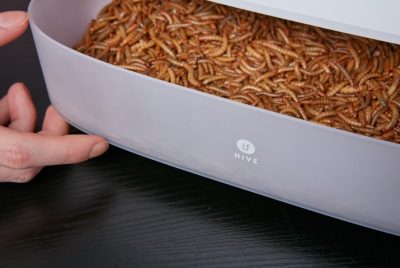
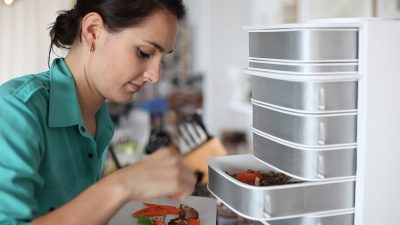
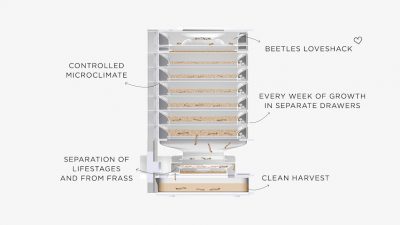
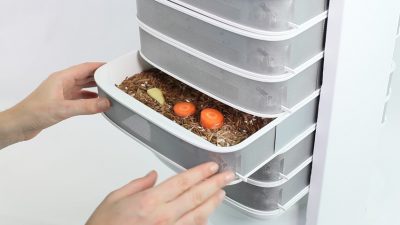
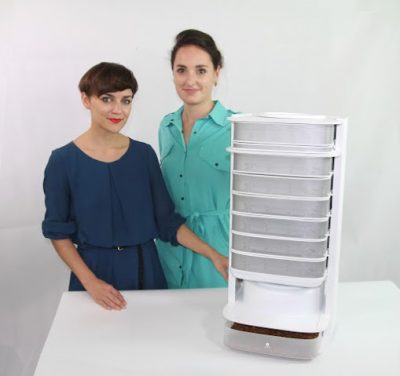
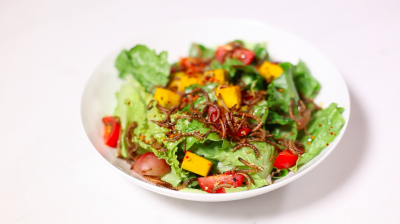

No Comments Yet!
You can be first to comment this post!